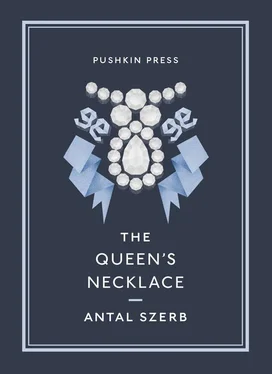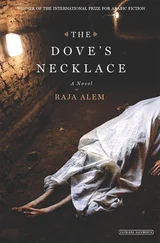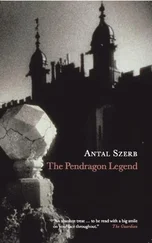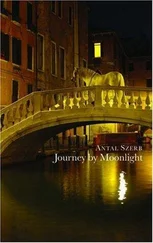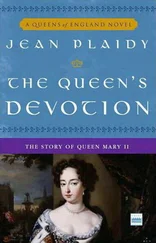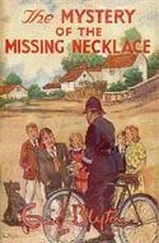They were descended in a direct line on their father’s side from Henri II (the son of François I, The Great) who ruled from 1547 to 1559. Their great-great-grandfather, Henri de Saint-Rémy, was the offspring of Henri’s liaison with Nicole de Savigny; Henri acknowledged his son and declared him legitimate. In terms of blood, they stood perhaps even closer to the throne of St Louis than the ruling Bourbons. Their coat of arms consisted of two bundles of sticks on a field argent, beneath three lilies, the illustrious lilies of Valois. “The little beggar-girl was familiar with the crest, and indeed it was the only thing, in her terrible abandonment, that she did know,” declares Funck-Brentano. “And when she spoke in such astonishing detail about it, or about her ancestor the royal bastard born to Nicole de Savigny, her little body, bowed as it was with oppression, became erect, proud and defiant.”
And with good reason. The blood of Valois in one’s veins — what a fatal inheritance, and what a cursed Nibelung treasure! Perhaps the most fundamental and interesting scholarly debate of our century is whether a person’s character and fate are determined before or after birth: by inheritance or environment; by ‘genes’ or behaviourism; by those mysterious little bodies which are passed on from one’s ancestors to one’s descendants, or by the ‘conditioned reflexes’ acquired in childhood, instinctive modes of behaviour, which repeat themselves in response to certain conditions.
Probably both camps are right, or rather, neither is. Inheritance must play some role in shaping human character, as must habits learnt in childhood, and besides the question of personality is highly complicated, and too complex to explain with reference to either of those factors alone or even as the product of the two working together. So perhaps we should not give excessive credence to the notion that the little beggar girl Jeanne inherited much of her nature from the Valois kings. With so many intermarriages down the generations, a proportion of somewhat less-than-aristocratic blood would also have flowed in her veins. A perfectly sufficient explanation of the way her character was shaped lies, as we have seen, in her childhood and her social situation when she became aware of the fact that she was a descendant of the house of Valois: her ancestry did indeed exercise a decisive influence on her fate, not through the mysterious workings of heredity but simply through her consciousness of it.
Nonetheless we might allow ourselves to play with the idea for a moment. They say miraculous throwbacks do occur …
The house of Valois ruled France from 1328 to 1589, throughout the Hundred Years War, the Renaissance and the centuries of barbarism. It was on their account that Joan of Arc was burnt at Rouen; it was they who forged a unified kingdom from a France hitherto divided into feudal estates; their proud armies fought in the Italy of Leonardo and Michelangelo; and it was they who ordered the St Bartholomew’s Day massacre. They included lunatics like Charles VI, bloody tyrants like Louis XI, and fiery-spirited Bohemian grandees like François I. They were a great and appalling family, famous hunters, with history resounding in every step they took. So why not see in this proud Jeanne, with her kittenish ferocity, her wildcat defiance and needle-sharp teeth, a spirit harking back to its forebears? Or again, in the story that is about to unfold (essentially a war between two women) why not see it moreover as two ancestral enemies still at each others’ throats — two families which, as the ‘neighbouring houses’ of Habsburg and Valois, shaped all Europe, and whose mutual hatred was passed on to later generations?
The Saint-Rémy family had lived for generations on their estate at Fontette, near Bar-sur-Aube, in the north-eastern part of France. They lived as becomes the sons of princes when not actually on the throne: they farmed and hunted, did the odd bit of poaching, and from time to time discreetly exercised the royal craft of coining. They certainly had need of the last, but, it seems, did not put it to very much use. Jeanne’s father, Jacques de Saint-Rémy, Baron de Luz and de Valois, was thoroughly impoverished. He no longer lived in the manor — its roof had fallen in and it was visibly crumbling — but in the farmhouse. He mixed with the peasantry, and married his village sweetheart, who became Jeanne’s mother. The woman finally bankrupted him, and when he fell ill she threw him out. He ended his miserable life in the Hôtel Dieu hospital in Paris. She then took up with a soldier; and now the fate of little Jeanne, who had been born in 1756, really took a turn for the worse. She was sent out to beg, and her foster father vented on her all the rage he felt against his own unbearable existence.
It was at this point that, in 1763, the Marquise de Boulainvilliers took little Jeanne into her home, together with her baby sister, who died of smallpox shortly afterwards. Jeanne was raised in a girl’s boarding school up to the age of fourteen, after which her patroness placed her with a Parisian dressmaker.
During the years when rococo was in fashion, such establishments ranked among the most celebrated places in Europe, just as they are in our day, perhaps even more so. One of the most striking features of Paris at the time was the number of dressmakers’ workshops and couturiers. Louis-Sébastien Mercier, to whom we shall frequently refer, compiled a wonderful inventory of the city in 1781, thus inaugurating that delightful genre, which has become popular only in our time, of books about cities. In his study he devotes a lengthy chapter to the seamstresses:
“They sit in their shops, side by side in rows, in full view of the street windows. They sew pompons, little accessories, the elegant insignia that fashion summons into being and then promptly replaces. You are free to stare in at them, and they are equally free to stare back at you.
“Chained to their workbenches, needle in hand, the girls are forever glancing out into the street. No passer-by can avoid their eye. There is an army of men queuing up to bestow their admiring stares, and a fierce struggle is waged for the place nearest the window.
“The girls are thrilled by the looks directed at then, and each imagines that every man is in love with her. The large number of passers-by simply adds to the variety, increases the glamour and inspires further curiosity. This is what makes their professional bondage tolerable, the combined pleasures of seeing and being seen. But one has to arrange things so that the prettiest girl is always seated nearest the window.
“Every morning they set forth in large numbers, with their baskets of pompons, to call on great ladies at their dressing tables. Their task is to adorn the brows of their rivals in beauty; they must keep their secret sexual jealousies to themselves and behave in a professional manner while titivating the good looks of those who treat them with contemptuous indifference. Sometimes the shop girl is so very pretty that the proud brow of her wealthy patroness pales to insignificance beside her. The beau is instantly unfaithful; his eyes are on the watch only for the fresh little mouth and ruddy face in the corner of the mirror … but she of course has neither footmen nor family.
“Quite a few of these girls will make it in one bound into an English carriage. A month ago she was a mere shop girl; now when she arrives with her wares her head is held high, her face a picture of triumph, while her former supervisor and ‘dear, dear colleagues’ turn green with envy.
“There are some establishments where the tone is strict and the girls are all very respectful, but even the proprietress finds this astonishing, and recounts the fact to everyone as if it were some sort of universal miracle. It is as if she has a wager that one day she will be able to say, ‘There is in Paris one fashion house where every girl is a virgin, and it’s all due to my strength of character and vigilance.’”
Читать дальше
